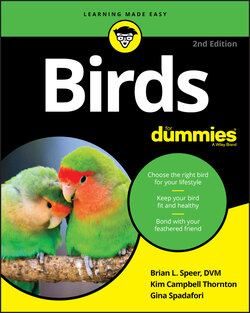Читать книгу Birds For Dummies - Gina Spadafori - Страница 20
Putting in the time
ОглавлениеForget any notion you ever had about birds being low-maintenance pets. Canaries and finches can fall loosely into that category, although even those species require more attention than you may expect, but the same can’t be said of all the other birds we love as pets. From budgies to cockatiels to the flashiest of macaws, birds can be — how shall we say this politely? — demanding. You can’t just put them in a cage, change the papers, add food and water, and ignore them. They won’t let you.
Most of the birds people keep as pets are highly intelligent and very social. People often have denied them the company of their own kind and the stimulation of an appropriate environment. We ask them to be happy with us — and they can be, but not without effort on our part. And effort takes time. When you take one of these sentient beings into your life, you must take responsibility for her health, happiness, and welfare. If you’re not prepared to spend that time working with your bird, training your bird, providing healthy social interaction for your bird, and allowing your bird plenty of supervised out-of-cage time to enjoy, you’re going to have an unhappy bird. An unhealthy bird. A biter. A screamer. A feather-picker. And it doesn’t need to be that way.
Cared for properly, birds can be as time-consuming as dogs. Really. They need to be loved, handled, trained, fed, and cleaned up after — a lot! If you don’t have that kind of time and energy, reconsider choosing a bird as a companion unless you’re sure you’ll enjoy the pleasant sounds of a charm of finches (charm is the delightful term for a group of finches), who prefer the society of their own kind rather than interactions with humans.
With any relationship, the more you put into it, the more you get out of it. The same is true when it comes to birds. The more time you spend with your bird, the more loving and socialized she’ll be — and the more time you’ll want to spend with her as a result! But don’t forget to grant these individuals the opportunity to be just that: individuals. Their personalities and their likes and dislikes vary just as much as ours do. Not all birds are suited to all people and living circumstances. In this regard, think of them as feathered humans.
Another aspect of time that you need to consider when it comes to birds: longevity, yours and theirs. Healthy pet parrots can live for decades, which requires a major commitment to such companionship. In general, the larger the parrot species, the longer the life expectancy. For example, the large macaws can live 70 to 100 years or more, while the little budgerigars rarely will live to be 20 years old.
Can you imagine spending most of your life with a pet? Are you able to plan for the pet who outlives you? These issues are very real for bird owners, and you need to factor them into your decision-making. Some pet trusts, which ensure that pets are cared for after an owner’s death, can be in effect for up to 150 years — a must if you have a long-lived pet such as a macaw, Amazon parrot, or tortoise.
For help in understanding an older bird and in keeping her healthy, check out Chapter 11.
